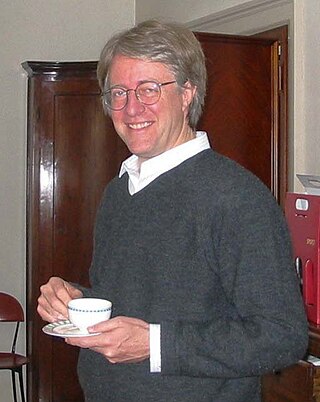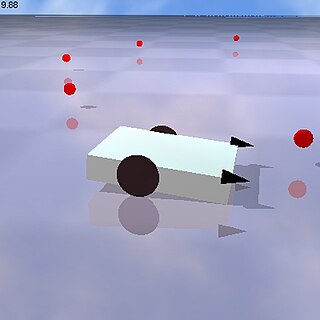
In computer science and operations research, a genetic algorithm (GA) is a metaheuristic inspired by the process of natural selection that belongs to the larger class of evolutionary algorithms (EA). Genetic algorithms are commonly used to generate high-quality solutions to optimization and search problems by relying on biologically inspired operators such as mutation, crossover and selection. Some examples of GA applications include optimizing decision trees for better performance, solving sudoku puzzles, hyperparameter optimization, causal inference, etc.
In computational intelligence (CI), an evolutionary algorithm (EA) is a subset of evolutionary computation, a generic population-based metaheuristic optimization algorithm. An EA uses mechanisms inspired by biological evolution, such as reproduction, mutation, recombination, and selection. Candidate solutions to the optimization problem play the role of individuals in a population, and the fitness function determines the quality of the solutions. Evolution of the population then takes place after the repeated application of the above operators.

In computer science, evolutionary computation is a family of algorithms for global optimization inspired by biological evolution, and the subfield of artificial intelligence and soft computing studying these algorithms. In technical terms, they are a family of population-based trial and error problem solvers with a metaheuristic or stochastic optimization character.
Bio-inspired computing, short for biologically inspired computing, is a field of study which seeks to solve computer science problems using models of biology. It relates to connectionism, social behavior, and emergence. Within computer science, bio-inspired computing relates to artificial intelligence and machine learning. Bio-inspired computing is a major subset of natural computation.
A digital organism is a self-replicating computer program that mutates and evolves. Digital organisms are used as a tool to study the dynamics of Darwinian evolution, and to test or verify specific hypotheses or mathematical models of evolution. The study of digital organisms is closely related to the area of artificial life.

Avida is an artificial life software platform to study the evolutionary biology of self-replicating and evolving computer programs. Avida is under active development by Charles Ofria's Digital Evolution Lab at Michigan State University; the first version of Avida was designed in 1993 by Ofria, Chris Adami and C. Titus Brown at Caltech, and has been fully reengineered by Ofria on multiple occasions since then. The software was originally inspired by the Tierra system.
Interactive evolutionary computation (IEC) or aesthetic selection is a general term for methods of evolutionary computation that use human evaluation. Usually human evaluation is necessary when the form of fitness function is not known or the result of optimization should fit a particular user preference.
In natural evolution and artificial evolution the fitness of a schema is rescaled to give its effective fitness which takes into account crossover and mutation.
In artificial intelligence, artificial immune systems (AIS) are a class of computationally intelligent, rule-based machine learning systems inspired by the principles and processes of the vertebrate immune system. The algorithms are typically modeled after the immune system's characteristics of learning and memory for use in problem-solving.

Thomas S. Ray is an evolutionary biologist known for his research in tropical biology, digital evolution, and the human mind.

Norman Harry Packard is a chaos theory physicist and one of the founders of the Prediction Company and ProtoLife. He is an alumnus of Reed College and the University of California, Santa Cruz. Packard is known for his contributions to chaos theory, complex systems, and artificial life. He coined the phrase "the edge of chaos".
Artificial creation is a field of research that studies the primary synthesis of complex lifelike structures from primordial lifeless origins.
Extremal optimization (EO) is an optimization heuristic inspired by the Bak–Sneppen model of self-organized criticality from the field of statistical physics. This heuristic was designed initially to address combinatorial optimization problems such as the travelling salesman problem and spin glasses, although the technique has been demonstrated to function in optimization domains.
Autoconstructive evolution is a process in which the entities undergoing evolutionary change are themselves responsible for the construction of their own offspring and thus for aspects of the evolutionary process itself. Because biological evolution is always autoconstructive, this term mainly occurs in evolutionary computation, to distinguish artificial life type systems from conventional genetic algorithms where the GA performs replication artificially. The term was coined by Lee Spector.
Dr. Charles A. Ofria is a Professor in the Department of Computer Science and Engineering at Michigan State University, the director of the Digital Evolution (DEvo) Lab there, and Director of the BEACON Center for the Study of Evolution in Action. He is the son of the late Charles Ofria, who developed the first fully integrated shop management program for the automotive repair industry. Ofria attended Stuyvesant High School and graduated from Ward Melville High School in 1991. He obtained a B.S. in Computer Science, Pure Mathematics, and Applied Mathematics from Stony Brook University in 1994, and a Ph.D. in Computation and Neural Systems from the California Institute of Technology in 1999. Ofria's research focuses on the interplay between computer science and Darwinian evolution.
Artificial development, also known as artificial embryogeny or machine intelligence or computational development, is an area of computer science and engineering concerned with computational models motivated by genotype–phenotype mappings in biological systems. Artificial development is often considered a sub-field of evolutionary computation, although the principles of artificial development have also been used within stand-alone computational models.
Natural computing, also called natural computation, is a terminology introduced to encompass three classes of methods: 1) those that take inspiration from nature for the development of novel problem-solving techniques; 2) those that are based on the use of computers to synthesize natural phenomena; and 3) those that employ natural materials to compute. The main fields of research that compose these three branches are artificial neural networks, evolutionary algorithms, swarm intelligence, artificial immune systems, fractal geometry, artificial life, DNA computing, and quantum computing, among others.

Artificial life is a field of study wherein researchers examine systems related to natural life, its processes, and its evolution, through the use of simulations with computer models, robotics, and biochemistry. The discipline was named by Christopher Langton, an American theoretical biologist, in 1986. In 1987 Langton organized the first conference on the field, in Los Alamos, New Mexico. There are three main kinds of alife, named for their approaches: soft, from software; hard, from hardware; and wet, from biochemistry. Artificial life researchers study traditional biology by trying to recreate aspects of biological phenomena.

Evolving digital ecological networks are webs of interacting, self-replicating, and evolving computer programs that experience the same major ecological interactions as biological organisms. Despite being computational, these programs evolve quickly in an open-ended way, and starting from only one or two ancestral organisms, the formation of ecological networks can be observed in real-time by tracking interactions between the constantly evolving organism phenotypes. These phenotypes may be defined by combinations of logical computations that digital organisms perform and by expressed behaviors that have evolved. The types and outcomes of interactions between phenotypes are determined by task overlap for logic-defined phenotypes and by responses to encounters in the case of behavioral phenotypes. Biologists use these evolving networks to study active and fundamental topics within evolutionary ecology.

The following outline is provided as an overview of and topical guide to evolution:








